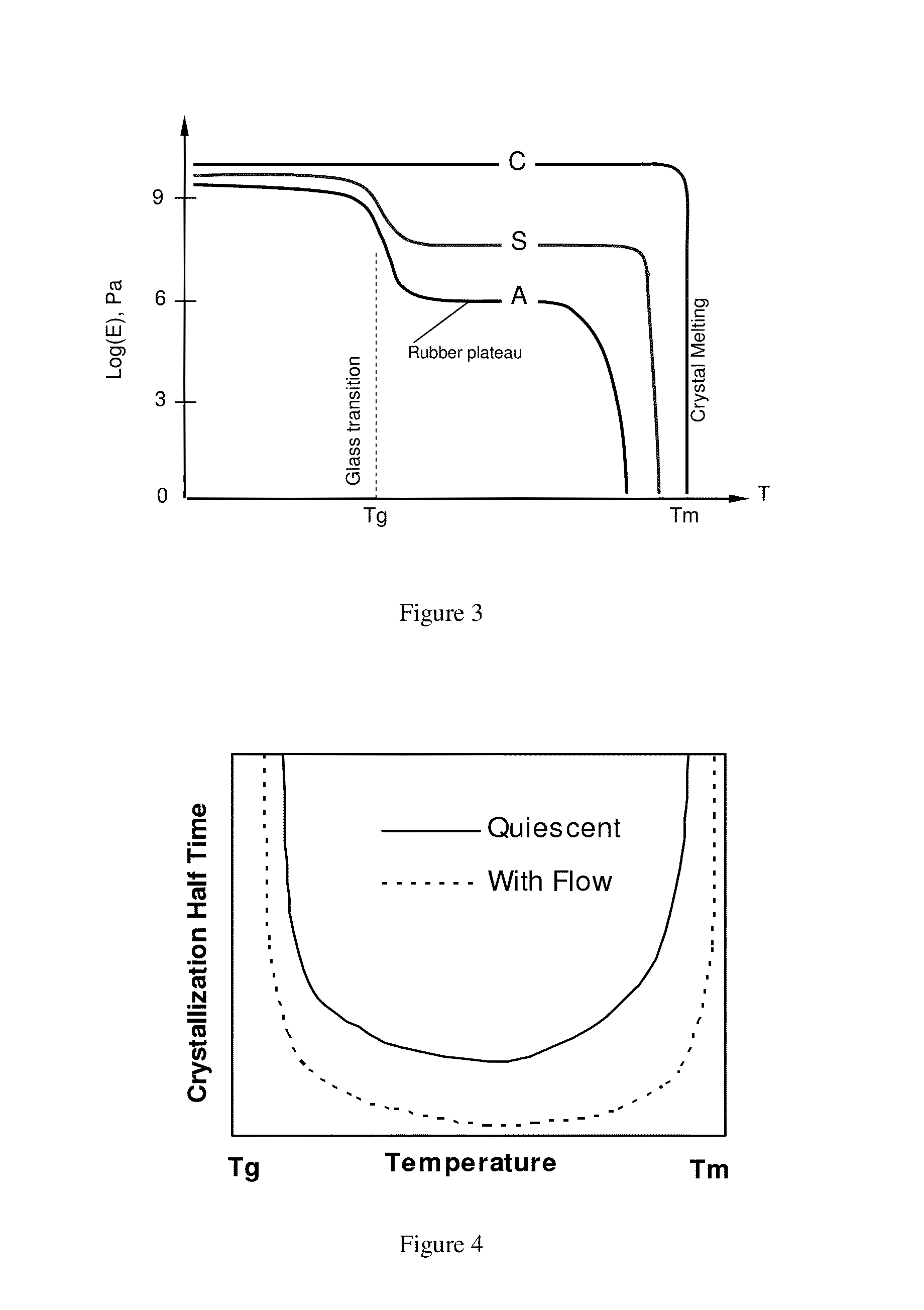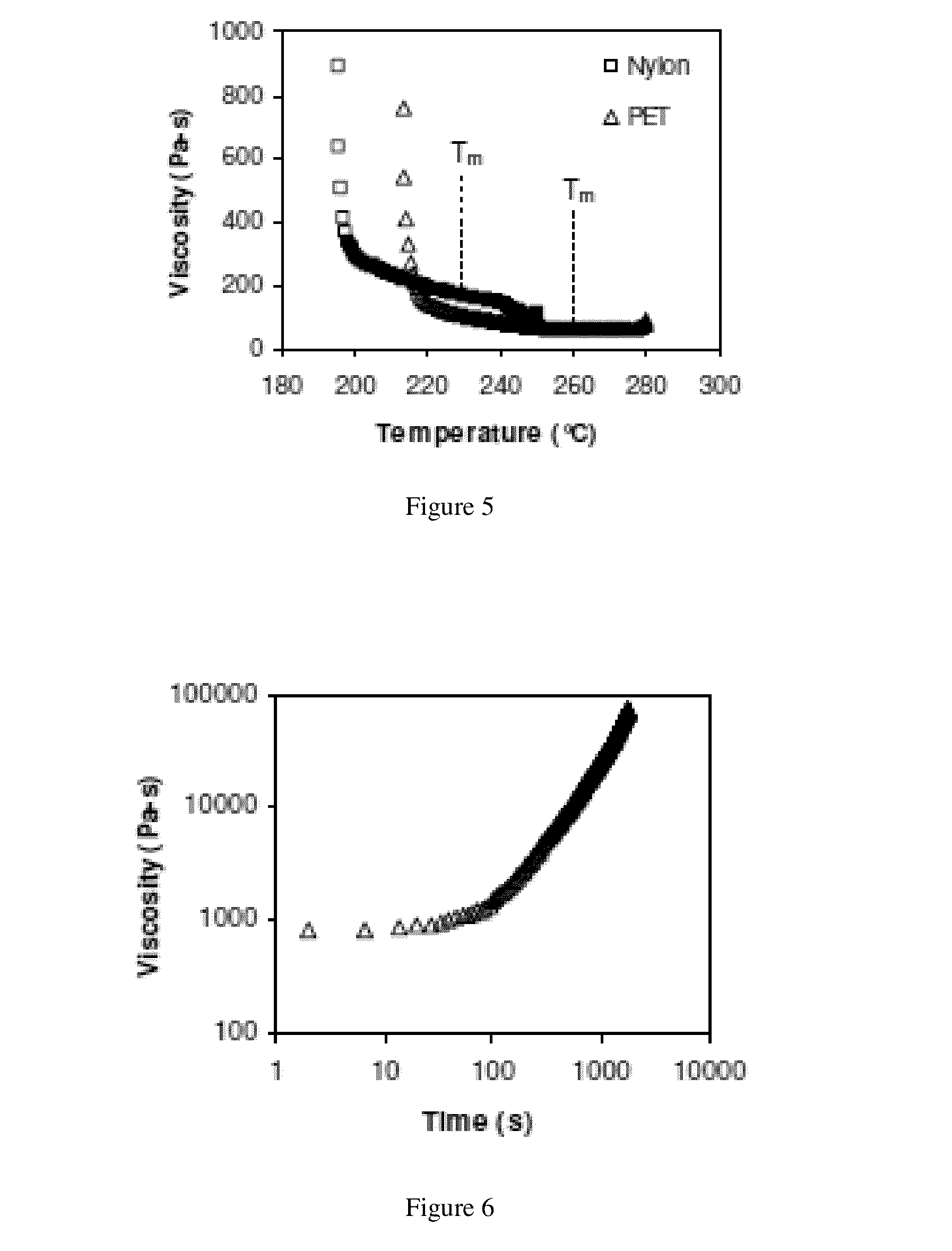Quasi-melt processes for single polymer composites and products thereof
- Summary
- Abstract
- Description
- Claims
- Application Information
AI Technical Summary
Benefits of technology
Problems solved by technology
Method used
Image
Examples
example 1
Quasi-Melts and Tq
[0068]Semicrystalline polymer with a relatively high molecular weight can form a stable quasi-melt at a temperature well below the melting temperature. Experiments involving DSC (differential scanning calorimetry), parallel-plate rotational rheometry, polarized microscopy, and ram extrusion demonstrated that a quasi-melt of undercooled polymer melt can be created. Supercooled melts of PP, nylon, and PET can maintain a fluidic or viscous state for a long period of time (˜2 minutes or longer) at a temperature at least 20° C. below the polymer's melting temperature. Moreover, the viscosity of the quasi-melt is only moderately higher than that of the intrinsic melt above the melting temperature. For example, PP, with Tm at 170° C., can be extruded at 140° C. on a ram extruder with a designed temperature profile, and PET, with Tm at 260° C., can form a quasi-melt at 220° C., and this quasi-melt can be combined with high-strength PET fibers to form a single-polymer comp...
example 2
Ram Extrusion
[0071]Ram extrusion was performed on a capillary rheometer. However, for the standard capillary rheometer, the die temperature and the melt chamber temperature cannot be separately controlled. An external die with an independent heating element and a separate temperature control unit was fabricated and retrofitted to the capillary rheometer (FIG. 8(a)). Heating was performed by electrically insulated heating wires wrapped around the die surface. PP was used as a testing polymer. At the start of the experiment, both the chamber temperature and the die temperature were set to 200° C. After steady flow was developed, the die temperature was gradually reduced to its final target temperature. With this procedure, stable flow was achieved at die temperatures as low as 140° C., 30° C. below the melting temperature of PP. This indicated that, after deep cooling below the melting temperature, PP still kept a fluidic state. The experimental pressure and flow rate data were used f...
example 3
SPCs Processing with Quasi-Melt
[0072]PET, with a melting temperature of 260° C., was used for SPCs processing. A PET quasi-melt film was produced on a heated plate at 220° C. Highly drawn PET fibers were added to the quasi-melt in a unidirectional pattern. The liquid film was then folded and compression molded at the same temperature. FIG. 9(a) shows a fracture surface appearance for the PET SPC; nearly no fibers were pulled out on the fractured surface, indicating excellent interracial bonding achieved between the fibers and the matrix. For comparison, the fracture surface appearance of a glass fiber reinforced PET sheet is shown in FIG. 9(b). For this heterogeneous composite, fibers can be clearly seen at the fracture surface. With 30% PET fibers as reinforcement, the PET SPC sheet had a tensile strength about 5 times higher than the non-reinforced PET sheet.
PUM
| Property | Measurement | Unit |
|---|---|---|
| Fraction | aaaaa | aaaaa |
| Fraction | aaaaa | aaaaa |
| Percent by mass | aaaaa | aaaaa |
Abstract
Description
Claims
Application Information
 Login to View More
Login to View More - R&D Engineer
- R&D Manager
- IP Professional
- Industry Leading Data Capabilities
- Powerful AI technology
- Patent DNA Extraction
Browse by: Latest US Patents, China's latest patents, Technical Efficacy Thesaurus, Application Domain, Technology Topic, Popular Technical Reports.
© 2024 PatSnap. All rights reserved.Legal|Privacy policy|Modern Slavery Act Transparency Statement|Sitemap|About US| Contact US: help@patsnap.com










